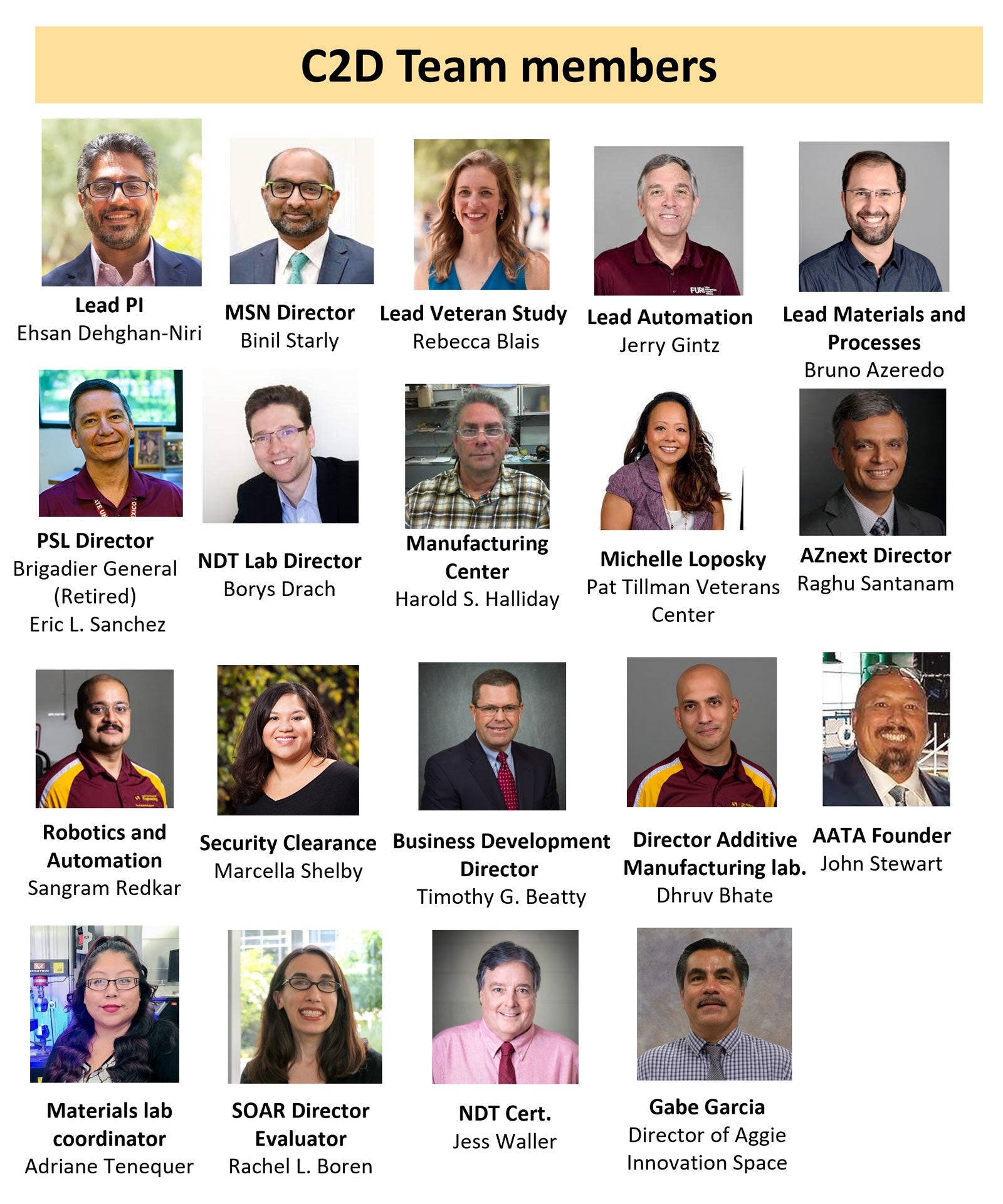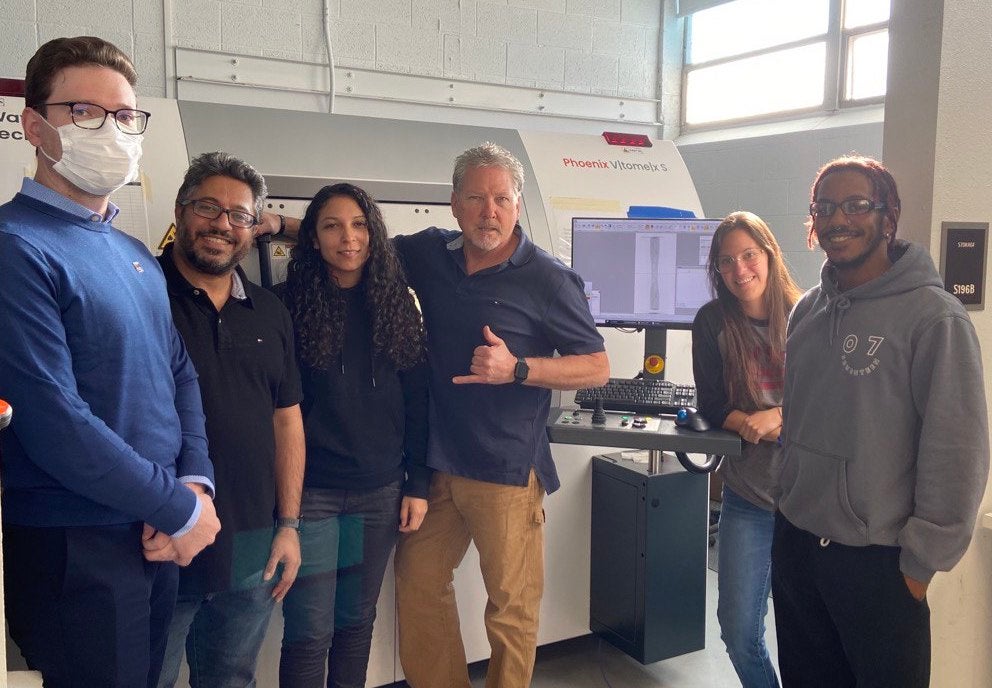Modernizing military preparedness

Arizona State University’s Ira A. Fulton Schools of Engineering is teaming with New Mexico State University, Navajo Technical University and the American Aerospace Technical Academy in a newly established Certification 2 Degree Consortium. The program aims to put students on career paths into STEM-related manufacturing industries to help produce technologies to prepare the U.S. for national defense challenges. Graphic by Rhonda Hitchcock-Mast/ASU
Editor’s note: This story has been edited for length. Read the full-length feature on Full Circle.
Strong national defense increasingly demands staying at the forefront of technological innovation.
The key to maintaining an advantage is having the resources and infrastructure to develop, manufacture and sustain the complex high-tech systems required to ensure effective protection against formidable opponents.
Ehsan Dehghan-Niri, an associate professor of manufacturing engineering in the School of Manufacturing Systems and Networks, part of the Ira A. Fulton Schools of Engineering at Arizona State University, was recently awarded a $3.5 million U.S. Department of Defense grant to lead efforts to overcome manufacturing workforce inadequacies.
“What we need at the ground level is a robust ecosystem geared toward inspiring and equipping individuals with the knowledge and skills required to efficiently manufacture the hardware necessary to modernize our military,” Dehghan-Niri said.
Opening career paths for future STEM experts
With the funding from the DOD, Dehghan-Niri and several colleagues are beginning work to construct a more flexible and sustainable manufacturing workforce development pipeline to help the country’s military forces prepare to engage in future international conflict scenarios.
ASU faculty members will join collaborators at New Mexico State University (NMSU), Navajo Technical University (NTU) and the American Aerospace Technical Academy (AATA) on the project, with Dehghan-Niri directing work to create a manufacturing-focused Certification to Degree, or C2D, Consortium designed to equip students with skills through hybrid certification programs that will open paths for them to earn science, technology, engineering and math, or STEM, certifications or degrees with a focus on manufacturing.
The C2D’s innovative approach, Dehgan-Niri says, uses early integration of hands-on, skill-oriented methodologies coupled with industry collaboration to foster deeper engagement among students and introduce them to potential manufacturing career pathways.
Photo composite courtesy Ehsan Dehghan-Niri/ASU
Building skills to advance national security efforts
“To better position the current and next-generation manufacturing workforce to produce military systems and components, the two main gaps in the manufacturing workforce and the gap in certain skills must be addressed efficiently and simultaneously,” says Dehghan-Biri.
The project team will develop two hybrid certification programs to teach advanced manufacturing and nondestructive testing — a set of inspection techniques and methods used in many industries to evaluate the integrity, quality and properties of materials, components or structures without causing any damage or altering their physical properties, which is one of Dehghan-Niri’s areas of expertise, and customized cyber-learning tools to use in efficiently teaching students.
Both certification programs’ cyber-learning components will include online learning and the use of a shared C2D digital laboratory using virtual reality, or VR, modules for early exposure to simulation training. The digital laboratory offers students a safe and efficient simulated hands-on experience, enabling them to gain familiarity with expensive and potentially hazardous manufacturing equipment virtually before undergoing practical training.
Career opportunities for military veterans and underserved communities
The project aims to help two groups increase their potential to supply defense industry with an expanding source of trained workers — military veterans and students from underrepresented communities.
The consortium will be unique in its regional impact on minority students as it integrates two Hispanic-Serving Institutions, ASU and NMSU, as well as tribal colleges and universities like NTU, in a cross-disciplinary partnership. In addition to these three academic partners, the AATA, a well-established nonprofit training institute with experience in supporting veterans in the fields of nondestructive testing and manufacturing training and certification, will help to establish the consortium.
Binil Starly, professor of manufacturing engineering and director of the School of Manufacturing Systems and Networks, says growing a larger source of skilled job candidates for companies that are supplying the U.S. government with advanced technology is nothing less than essential to the nation’s future.
Fulton Schools Associate Professor Ehsan Dehghan-Niri (second from left) poses in the Intelligent Structreus and Nondestructive Evaluation Laboratory at New Mexico State University, where he provided hands-on training to students and tech industry workers on how to use the lab’s advanced manufacturing-related technology — including a computed tomography, or CT, scanner supplied by the U.S. Department of Defense. Pictured are NMSU Associate Professor Borys Drach (to Dehghan-Niri’s left) tech industry workers Patty Castillo and Brad Stewart, a U.S. military veteran, and NMSU graduate students Veronica Gurrola and Darin McFadden. Photo courtesy Ehsan Dehghan-Niri/ASU
Tailoring manufacturing education for adaption
One major problem the C2D Consortium aims to overcome is that many conventional STEM academic programs lack a clear and concise focus and are not easily adaptable to changing and evolving skill sets required by industry.
Another problem is that many STEM degree programs don’t adequately address the major challenges faced by the manufacturing industry. In addition, students who enroll in these programs lack an adequate understanding of potential future employment opportunities.
To help remedy such problems, students will have opportunities to develop skills through industry collaborations and an introduction to standard practices and innovation in areas such as nondestructive testing, robotics, automation and additive manufacturing. They will also receive information about the array of varied career pathways that are expanding within the manufacturing world.
Giving workers valuable roles in defending the nation
Collaborators at the project’s partner institutions are optimistic about the value and potential impacts of the program, including the enhancement of workforce development in the Southwest region; the potentially transformative approach of its virtual reality training; and the support from a wide array of stakeholders, including 12 companies, nine of which are major defense manufacturers and contractors.
Dehghan-Niri noted that additional support is coming from the U.S. Department of Energy’s National Nuclear Security Administration and Sandia National Laboratories, as well as four U.S. Congress members.
“This project is about creating what I call a field of hope,” Dehghan-Niri said. “We have established certification programs that enable people to move up from level one to level two and level three certifications, which will then also enable them to get good jobs without going through the full spectrum of higher education in STEM fields. Plus, they will be contributing to something that will help protect their country.”
More Science and technology

4 ASU researchers named senior members of the National Academy of Inventors
The National Academy of Inventors recently named four Arizona State University researchers as senior members to the prestigious…

Transforming Arizona’s highways for a smoother drive
Imagine you’re driving down a smooth stretch of road. Your tires have firm traction. There are no potholes you need to swerve to…

The Sun Devil who revolutionized kitty litter
If you have a cat, there’s a good chance you’re benefiting from the work of an Arizona State University alumna. In honor of…



